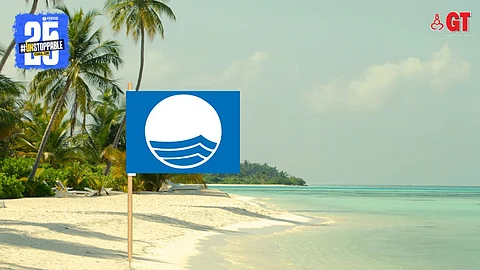Why Goa's beaches deserve Blue Flag certification
Sridhar D Iyer
Goa is generally imagined as a sun-kissed paradise with postcard-perfect beaches, swaying palms, and a vibrant tourist culture. With a 105-km coastline dotted with 51 beaches — 23 in North Goa and 28 in the south — the State is a beach lover's dream.
However, beyond its natural beauty lies the growing need for sustainable beach management. This is where the globally recognised Blue Flag Certification (BFC) comes into the picture.
Could adopting the Blue Flag eco-label elevate Goa’s beaches to international standards while preserving their charm? The answer, although layered, is worth exploring.
The Blue Flag Programme was initiated in 1985 by the Foundation for Environmental Education (FEE), headquartered in Copenhagen, Denmark. With 77 member countries, the BFC is awarded to beaches, marinas and sustainable boating tourism operators that meet stringent environmental, safety, and accessibility standards.
The international jury that evaluates sites includes representatives from FEE, the United Nations Environment Programme (UNEP), the World Tourism Organisation (UNWTO), and the International Union for Conservation of Nature (IUCN).
The Blue Flag Programme was initiated in 1985 by the Foundation for Environmental Education (FEE), headquartered in Copenhagen, Denmark.
There are 33 criteria under the Blue Flag scheme — ranging from water quality and waste management to safety and environmental education — that must be fulfilled to earn this prestigious label.
Beaches with a Blue Flag not only offer a clean and hygienic experience, but also become models of balanced tourism, attracting environmentally-conscious travellers.
Under the BFC, facilities such as shower and change rooms, solar-powered toilets, drinking water kiosks, well-maintained seating areas, parking spaces, lighting and signage are allowed within 10 meters of the high tide line, without requiring separate clearances under the Coastal Regulation Zone (CRZ) Notification.
The scheme also permits 500-meter designated swimming zones while leaving adjoining areas available for fishing and water sports.
To support this vision in India, the Ministry of Environment, Forest and Climate Change introduced the Beach Environment & Aesthetics Management Services (BEAMS) programme as part of its Integrated Coastal Zone Management Project.
BEAMS aims to reduce pollution in coastal waters, improve beach infrastructure, protect natural ecosystems, and ensure the safety of beachgoers.
Currently, India has 12 Blue Flag beaches, including Golden Beach (Odisha), Shivrajpur (Gujarat), Ghoghla (Diu), Kasargod and Padubidri (Karnataka), Kappad (Kerala), Eden Beach (Puducherry), Kovalam (Tamil Nadu), Rushikonda (Andhra Pradesh), Radhanagar (Andaman & Nicobar), and Thundi and Kadmat (Lakshadweep).
Spain leads globally with over 600 Blue Flag beaches — an achievement made possible through committed government policy, citizen involvement, and responsible tourism.
Currently, India has 12 Blue Flag beaches, including Golden Beach (Odisha), Shivrajpur (Gujarat), Ghoghla (Diu), Kasargod and Padubidri (Karnataka), Kappad (Kerala), Eden Beach (Puducherry), Kovalam (Tamil Nadu), Rushikonda (Andhra Pradesh), Radhanagar (Andaman & Nicobar), and Thundi and Kadmat (Lakshadweep).
WHERE DOES GOA STAND IN THIS EQUATION?
Despite its tourism appeal, several of Goa’s beaches lack essential infrastructure. While many offer water sports and shacks, they fall short when it comes to basic amenities like clean washrooms, cloakrooms, properly marked parking spaces, safety towers and information booths.
Furthermore, there’s little transparency on whether water quality is being tested regularly, a core criterion for Blue Flag status. This gap not only impacts the tourist experience, but could also affect marine and coastal ecosystems in the long run.
In July 2019, Miramar Beach in Panjim was identified for Blue Flag Certification by the Ministry of Environment, Forest and Climate Change. However, in October of the same year, the Goa High Court stayed the process following objections from local activists and fishing communities.
Their concerns included possible ecological damage and loss of traditional livelihood access. This brings forth the delicate balance Goa must strike between development and preservation.
In July 2019, Miramar Beach in Panjim was identified for Blue Flag Certification by the Ministry of Environment, Forest and Climate Change. However, in October of the same year, the Goa High Court stayed the process following objections from local activists and fishing communities.
Still, all is not lost. A pilot project could serve as a feasible compromise. Authorities could select a less frequented beach that already meets many of the BFC criteria and upgrade it to full certification.
Once certified, this beach could serve as a showcase model promoted through tourism campaigns, social media, and eco-travel platforms. If successful, it may pave the way for more beaches in Goa to follow suit, especially those already equipped with partial infrastructure.
More importantly, obtaining a Blue Flag Certification does not involve any monetary cost — it is a voluntary award that is valid for one year and needs to be renewed based on continuous adherence to its standards. Regular audits ensure that certified beaches maintain the required parameters, keeping the focus on long-term sustainability.
The Blue Flag Certification is not just about aesthetics or awards. It’s a holistic approach to beach management that brings together environmental stewardship, community participation, and tourist satisfaction.
The Blue Flag Certification is not just about aesthetics or awards. It’s a holistic approach to beach management that brings together environmental stewardship, community participation, and tourist satisfaction.
For Goa, it could mean protecting its natural heritage, creating local employment, improving tourist experiences, and positioning itself as a global leader in sustainable beach tourism.
In a world where ecological degradation is accelerating and responsible travel is gaining ground, the Blue Flag could become the badge of honour Goa’s beaches need. It’s time to look beyond the shacks and sunsets and think about longevity, legacy, and leading by example.
Let’s not wait until our beaches lose their natural charm. Let’s act now to preserve and promote them — for us and for the generations that follow.

